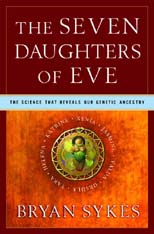HVR1 differences from
CRS -
16051G
-
16256T
-
16270T
-
16399G
-
16519C
-
HVR2 differences from
CRS
U5 Specific mitochondrial haplogroups are typically found in different regions of the world, and this is due to unique population histories. In the process of spreading around the world, many populations?with their special mitochondrial haplogroups?became isolated, and specific haplogroups concentrated in geographic regions. Today, we have identified certain haplogroups that originated in Africa, Europe, Asia, the islands of the Pacific, the Americas, and even particular ethnic groups. Of course, haplogroups that are specific to one region are sometimes found in another, but this is due to recent migration.
The mitochondrial super-haplogroup U encompasses haplogroups U1-U7 and haplogroup K. Haplogroup U, with its own multiple lineages nested within, is the oldest European-specific haplogroup, and its origin dates to approximately 50,000 years ago. Most likely arising in the Near East, and spreading into Europe in a very early expansion, the presence of haplogroup U5 in Europe pre-dates the expansion of agriculture in Europe. Interestingly, individuals with haplogroup U5 may have been come in contact with Neandertals living in Europe at the time.
Copyright 2007 Genealogy by Genetics, Ltd.
USAGE POLICY: Use of the above Haplogroup description requires written permission from Genealogy by Genetics.
Cambridge Reference Sequence
The mitochondrion sequenced in 1981 became known as the Cambridge Reference Sequence (CRS) and has been used as a basis for comparison with your mtDNA. In other words, any place in your mtDNA where you have a difference from the CRS, is characterized as a mutation. if your results show no mutations at all, it means that your mtDNA matches the CRS. A mutation happens a) when a base replaces another base - for example a C (Cytosine) replaces an A (Adenine), b) when a base is no longer in that position and c) when a new base is inserted between the other bases without replacing any other. Those mutations are represented below according to the following color code:
a) Mutation at position: RED b) Mutation Deleted: Strike c) Mutation Inserted: Green
The CRS is displayed below and we indicate where your differences are using the above color coding system. Please note that when you see "ATTCTAATTT" under 16010, it actually means that 16001 has an "A" (Adenine), 16002 has a "T" (Thymine), 16003 has a "T" (Thymine), 16004 has a "C" (Cytosine) and so on. If your table of mutations above indicates you have a difference "192T," the second letter in the section under 16200 will be a red "C" meaning that the CRS letter at that place is a "C," whereas yours is the "T" reported in the chart above.
HVR1 Reference Sequence (Starts At: 16001)
| 16010 | 16020 | 16030 | 16040 | 16050 | 16060 | 16070 | 16080 |
| ATTCTAATTT | AAACTATTCT | CTGTTCTTTC | ATGGGGAAGC | AGATTTGGGT | ACCACCCAAG | TATTGACTCA | CCCATCAACA |
| 16090 | 16100 | 16110 | 16120 | 16130 | 16140 | 16150 | 16160 |
| ACCGCTATGT | ATTTCGTACA | TTACTGCCAG | CCACCATGAA | TATTGTACGG | TACCATAAAT | ACTTGACCAC | CTGTAGTACA |
| 16170 | 16180 | 16190 | 16200 | 16210 | 16220 | 16230 | 16240 |
| TAAAAACCCA | ATCCACATCA | AAACCCCCTC | CCCATGCTTA | CAAGCAAGTA | CAGCAATCAA | CCCTCAACTA | TCACACATCA |
| 16250 | 16260 | 16270 | 16280 | 16290 | 16300 | 16310 | 16320 |
| ACTGCAACTC | CAAAGCCACC | CCTCACCCAC | TAGGATACCA | ACAAACCTAC | CCACCCTTAA | CAGTACATAG | TACATAAAGC |
| 16330 | 16340 | 16350 | 16360 | 16370 | 16380 | 16390 | 16400 |
| CATTTACCGT | ACATAGCACA | TTACAGTCAA | ATCCCTTCTC | GTCCCCATGG | ATGACCCCCC | TCAGATAGGG | GTCCCTTGAC |
| 16410 | 16420 | 16430 | 16440 | 16450 | 16460 | 16470 | 16480 |
| CACCATCCTC | CGTGAAATCA | ATATCCCGCA | CAAGAGTGCT | ACTCTCCTCG | CTCCGGGCCC | ATAACACTTG | GGGGTAGCTA |
| 16490 | 16500 | 16510 | 16520 | 16530 | 16540 | 16550 | 16560 |
| AAGTGAACTG | TATCCGACAT | CTGGTTCCTA | CTTCAGGGTC | ATAAAGCCTA | AATAGCCCAC | ACGTTCCCCT | TAAATAAGAC |
| 16569 | |
| ATCACGATG |
HVR2 Reference Sequence (Starts At: 1)
| 10 | 20 | 30 | 40 | 50 | 60 | 70 | 80 |
| GATCACAGGT | CTATCACCCT | ATTAACCACT | CACGGGAGCT | CTCCATGCAT | TTGGTATTTT | CGTCTGGGGG | GTATGCACGC |
| 90 | 100 | 110 | 120 | 130 | 140 | 150 | 160 |
| GATAGCATTG | CGAGACGCTG | GAGCCGGAGC | ACCCTATGTC | GCAGTATCTG | TCTTTGATTC | CTGCCTCATC | CTATTATTTA |
| 170 | 180 | 190 | 200 | 210 | 220 | 230 | 240 |
| TCGCACCTAC | GTTCAATATT | ACAGGCGAAC | ATACTTACTA | AAGTGTGTTA | ATTAATTAAT | GCTTGTAGGA | CATAATAATA |
| 250 | 260 | 270 | 280 | 290 | 300 | 310 | 320 |
| ACAATTGAAT | GTCTGCACAG | CCACTTTCCA | CACAGACATC | ATAACAAAAA | ATTTCCACCA | AACCCCCCCT | CCCCCCGCTTC |
| 330 | 340 | 350 | 360 | 370 | 380 | 390 | 400 |
| TGGCCACAGC | ACTTAAACAC | ATCTCTGCCA | AACCCCAAAA | ACAAAGAACC | CTAACACCAG | CCTAACCAGA | TTTCAAATTT |
| 410 | 420 | 430 | 440 | 450 | 460 | 470 | 480 |
| TATCTTTTGG | CGGTATGCAC | TTTTAACAGT | CACCCCCCAA | CTAACACATT | ATTTTCCCCT | CCCACTCCCA | TACTACTAAT |
| 490 | 500 | 510 | 520 | 530 | 540 | 550 | 560 |
| CTCATCAATA | CAACCCCCGC | CCATCCTACC | CAGCACACAC | ACACCGCTGC | TAACCCCATA | CCCCGAACCA | ACCAAACCCC |
| 570 | 580 | |
| AAAGACACCC | CCCA |
________________________________________________________________________
by Bryan Sykes


